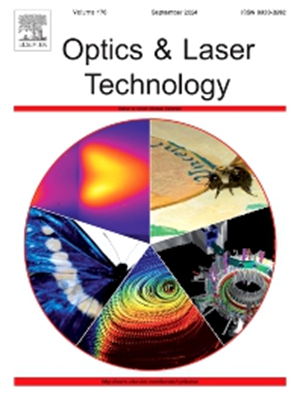基于锐度统计的傅立叶显微成像自动对焦算法
IF 4.6
2区 物理与天体物理
Q1 OPTICS
引用次数: 0
摘要
傅里叶显微成像技术是一种结合相位检索算法和合成孔径法实现高分辨率成像的计算成像技术。然而,由于样品不对准引起的散焦误差会显著降低重建质量,导致背景噪声增加和细节模糊。在这篇论文中,我们提出了一种新的基于清晰度统计的自动对焦算法来解决傅立叶显微成像中的散焦误差。与传统方法间接推断离焦误差不同,我们的方法直接对重建结果应用锐度检测策略,能够更准确地校正离焦引起的模糊。通过仿真和光学实验验证了基于锐度统计的自动对焦算法的有效性和鲁棒性,证明了该算法优于现有的光学瞳孔功能恢复像差校正算法和横向偏移校正方法。多组定量实验表明,在不同离焦场景下,本文方法估计的离焦距离比常用方法估计的离焦距离精度提高至少40%。因此,重建图像的对比度是常用方法的两倍以上。生物标本的图像质量也得到了提高,细节更清晰。结果表明,基于锐度统计的自动对焦算法能有效地校正离焦误差,提高图像质量。本文章由计算机程序翻译,如有差异,请以英文原文为准。
Sharpness-statistic based autofocus algorithm for Fourier ptychographic microscopy
Fourier ptychographic microscopy is a computational imaging technique that achieves high-resolution imaging by combining phase retrieval algorithms with synthetic aperture methods. However, defocus errors due to the misalignment of the sample can significantly degrade the reconstruction quality, leading to increased background noise and blurred details. In this manuscript, we propose a novel sharpness-statistic based autofocus algorithm to address defocus errors in Fourier ptychographic microscopy. Unlike conventional methods that infer defocus errors indirectly, our method directly applies a sharpness detection strategy to the reconstruction results, enabling more accurate correction of defocus-induced blurring. We validate the effectiveness and robustness of the sharpness-statistic based autofocus algorithm through both simulations and optical experiments, demonstrating its superiority over existing methods such as the embedded optical pupil function recovery aberration correction algorithm and lateral shift correction method. Multiple sets of quantitative experiments show that the defocus distances estimated by the proposed method under different defocusing scenarios are at least 40% more accurate than the ones estimated by the commonly used method. Consequently, the contrast of the reconstructed images is more than twice that of the commonly used method. The image quality of biological specimen is also improved with sharper details. The results indicate that the sharpness-statistic autofocus algorithm can effectively correct defocus error and enhance the image quality.
求助全文
通过发布文献求助,成功后即可免费获取论文全文。
去求助
来源期刊
CiteScore
8.50
自引率
10.00%
发文量
1060
审稿时长
3.4 months
期刊介绍:
Optics & Laser Technology aims to provide a vehicle for the publication of a broad range of high quality research and review papers in those fields of scientific and engineering research appertaining to the development and application of the technology of optics and lasers. Papers describing original work in these areas are submitted to rigorous refereeing prior to acceptance for publication.
The scope of Optics & Laser Technology encompasses, but is not restricted to, the following areas:
•development in all types of lasers
•developments in optoelectronic devices and photonics
•developments in new photonics and optical concepts
•developments in conventional optics, optical instruments and components
•techniques of optical metrology, including interferometry and optical fibre sensors
•LIDAR and other non-contact optical measurement techniques, including optical methods in heat and fluid flow
•applications of lasers to materials processing, optical NDT display (including holography) and optical communication
•research and development in the field of laser safety including studies of hazards resulting from the applications of lasers (laser safety, hazards of laser fume)
•developments in optical computing and optical information processing
•developments in new optical materials
•developments in new optical characterization methods and techniques
•developments in quantum optics
•developments in light assisted micro and nanofabrication methods and techniques
•developments in nanophotonics and biophotonics
•developments in imaging processing and systems

 求助内容:
求助内容: 应助结果提醒方式:
应助结果提醒方式:


